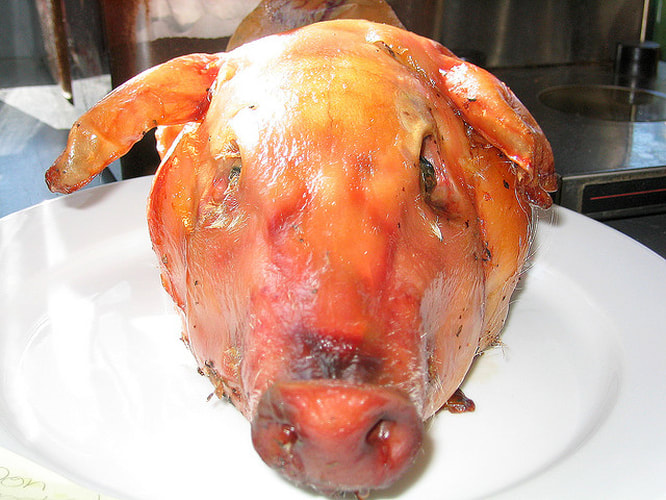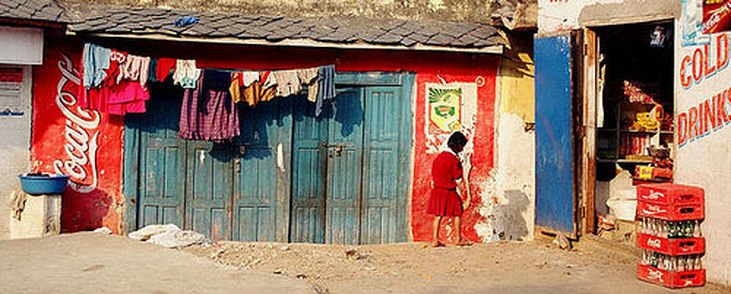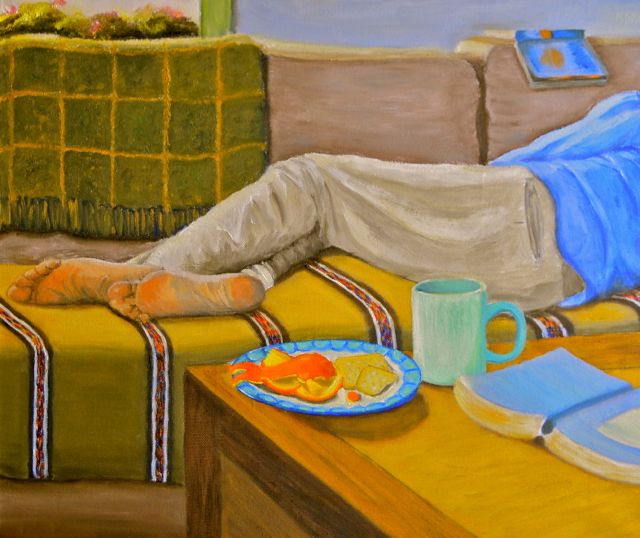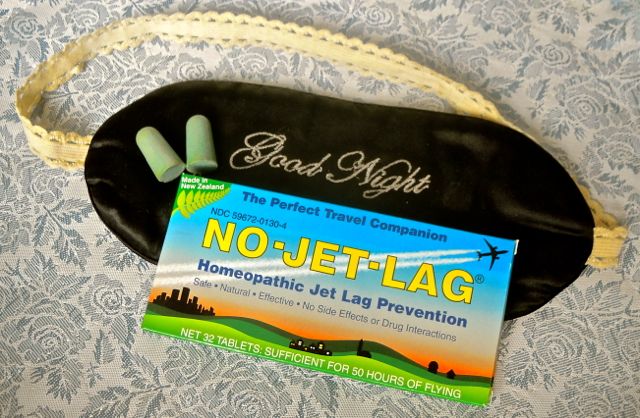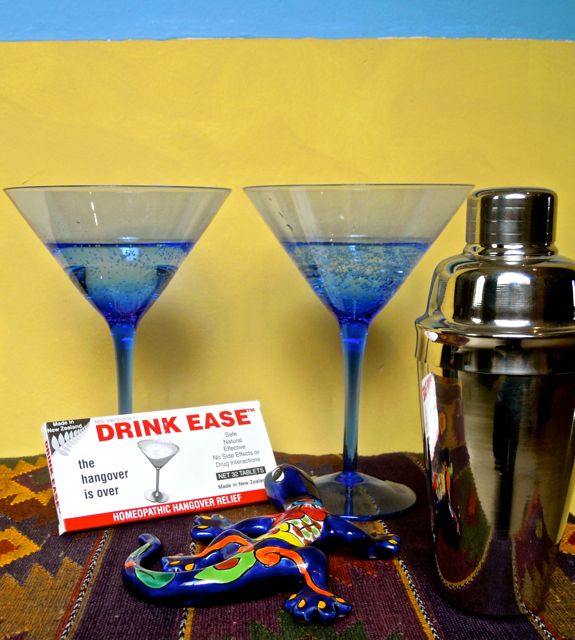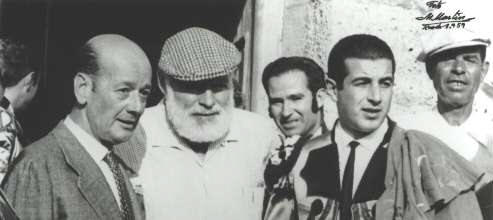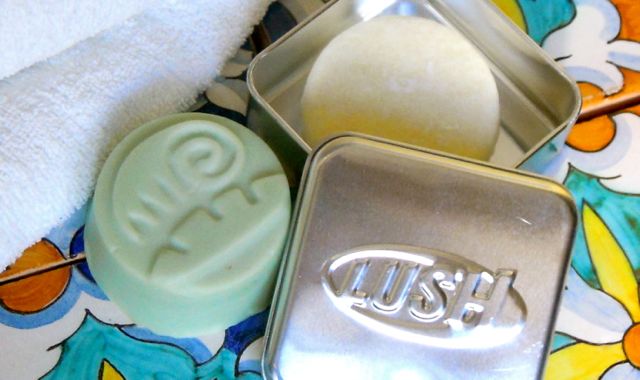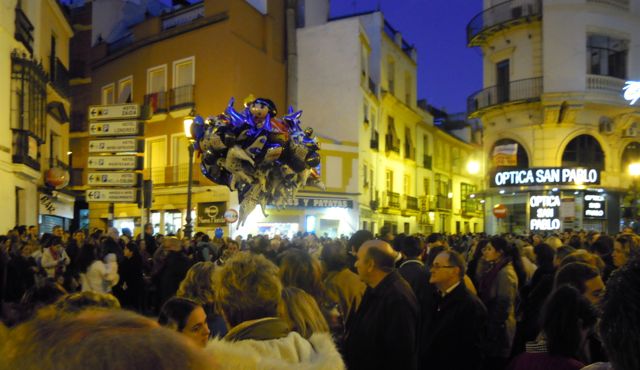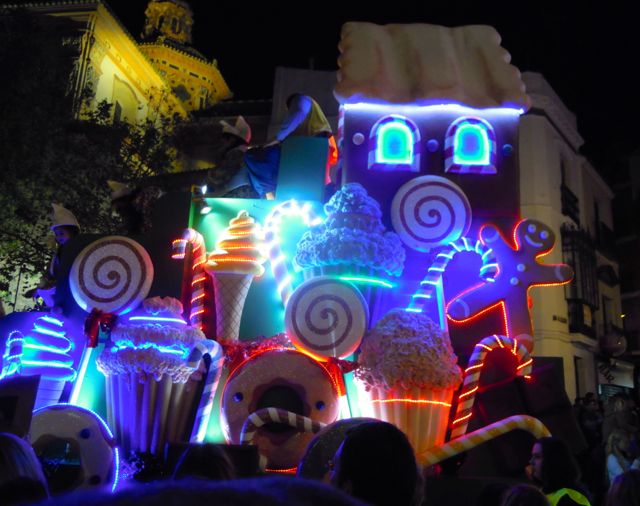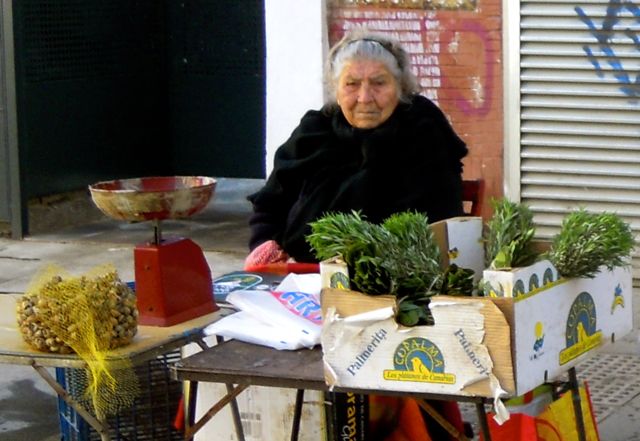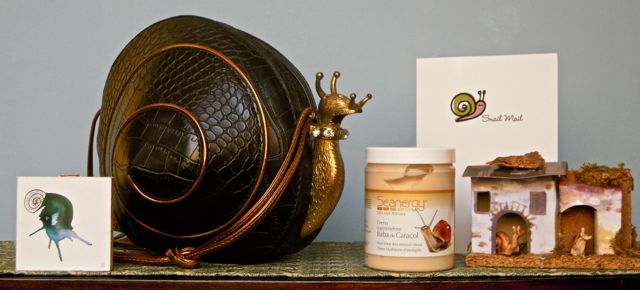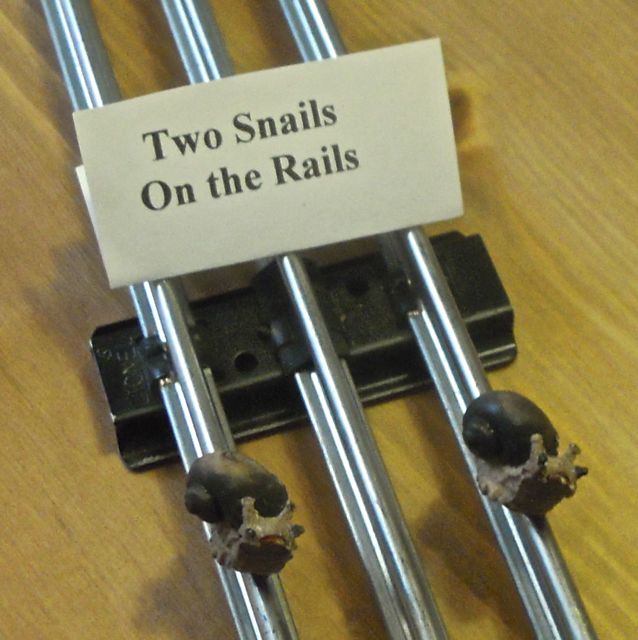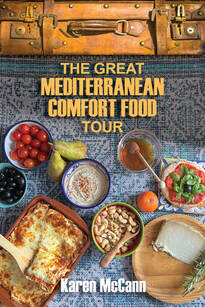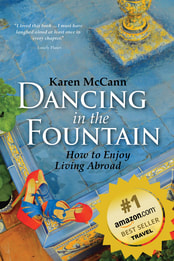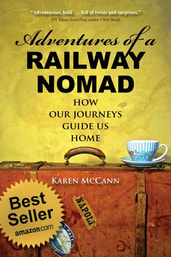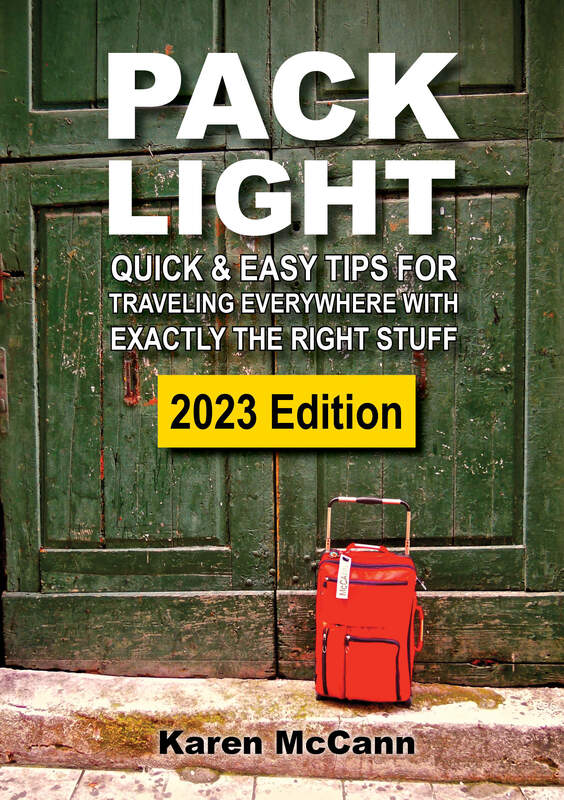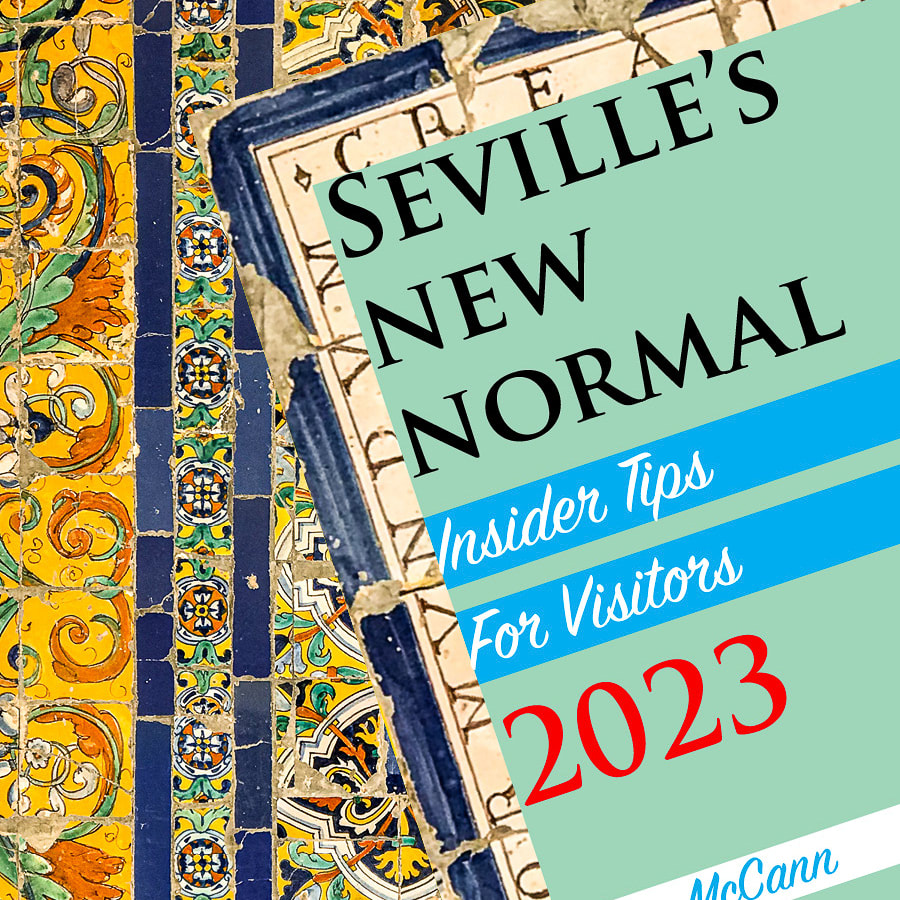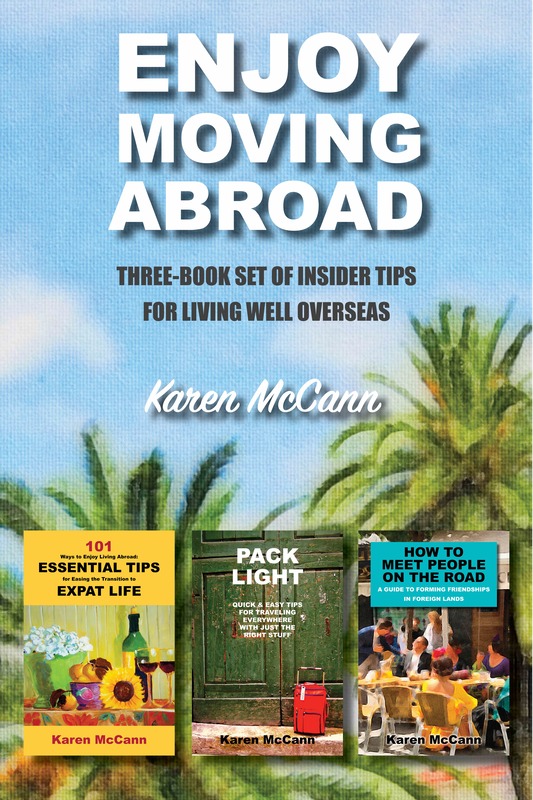|
One night in the old Soviet city of Tblisi, Georgia, at the end of many hours of toasting and feasting, our host took out a knife the size of a machete. He seized the remains of the whole roast pig, which by that point in the evening had been reduced to a few rib bones and the head. “And now,” he declared, “for our guests of honor, Karen and Rich – the brains of the pig!” With a single massive blow he cut the head in half. Extracting a small morsel from the interior, he held it out to me on the point of the blade. “For you!” Clearly this was an honor I couldn’t refuse. “You’re too kind!” I murmured and tossed the greasy morsel down with copious amounts of wine. (If you must know, it tasted like lard.) Another time we were in Thailand, and our guide ordered a plate of fried flies, passing them around the table for everyone to sample. Later, telling friends about this unconventional snack, I explained that it was salty, greasy and crunchy – a lot like cocktail peanuts, in fact. “How do you know they weren’t really peanuts?” one skeptic asked. “Well,” I said, “the wings were sort of a giveaway...” Sampling pig brains and fried flies make for good stories, but I wouldn’t recommend them as a steady diet. Some of the other odd things we’ve sampled – snake, for example, or alligator – are part of the everyday fare in other parts of the world. Here in Spain, we often eat colo de toro (tail of the bull), carillada (stewed pig cheeks) and angulas (baby eels). For health reasons, I draw the line at suspicious shellfish and raw meats, and avoid internal organs whenever possible. Except of course, for haggis. 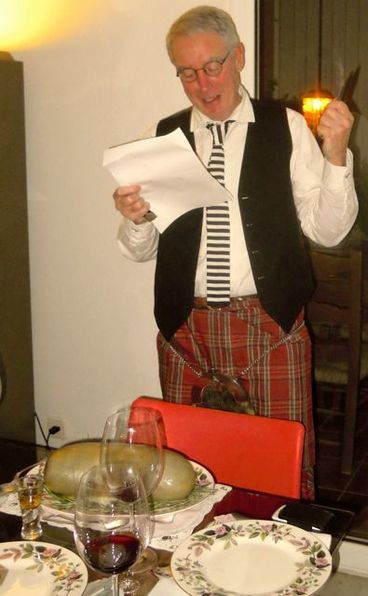 Rich doing his best to address the haggis in its native lanuguage. Rich doing his best to address the haggis in its native lanuguage. This year, Rich and I were lucky enough to be invited to share a haggis with friends at a Burns supper on January 25th, when people around the world gather to celebrate Scotland’s most famous poet, Robert Burns. Cue bagpipe music! Enter Rich, dressed in tartan and sporran with a dirk (dagger) tucked into his sock! He’d been asked to perform the ritual reading of Burns’ famous poem, Address to a Haggis, which begins Fair fa' your honest, sonsie face, Great chieftain o' the puddin-race! Aboon them a' ye tak your place, Painch, tripe, or thairm: Weel are ye wordy o' a grace As lang's my arm. After eight verses in this vein, Rich concluded with the traditional stabbing of the haggis, and the meal was served. For those of you who have not had the felicity to experience a haggis, I’ll explain that it’s a sheep’s stomach stuffed with sheep’s pluck (organs you don’t want to think about) minced with onion, oatmeal, suet and spices. Everybody always talks about the ghastly ingredients, but the flavor is actually quite delicious and savory. What they should warn you about is how staggeringly rich and filling it is. After a few bites I was ready to put down my fork, but I tried my best to do justice to the generous portion on my plate. A “wee dram” of Scotch whisky helped the haggis along. People sometimes ask me about the aftereffects of feasting on strange and exotic foods and what I do to restore my system’s equilibrium. Every country has its own remedy. After a very long night partying with some Georgian friends in their family’s farmhouse near the Chechnya border, we all gathered for a breakfast of their traditional morning-after pick-me-up: entrails soup. I’m talking about a bowl of broth with unspeakable parts of the cow floating in it. Cooked, thank heavens, but still ... Luckily the grandfather was entitled to the choicest serving; his bowl had a whole cow’s hoof sticking up out of it. When they asked if I would like a glass of vodka with my breakfast, I actually said yes. For the most part, these strange foods are much more challenging to contemplate than to digest. When my stomach does protest a bit, I usually turn to good old Coca-Cola. It’s available just about everywhere, and although it’s an everyday beverage now, there’s a reason it was originally sold in drug stores as a heath tonic. I don’t drink much of it in the ordinary course of things, but for settling the stomach after an excess of fried flies, haggis or home-made wine, it’s a much better pick-me-up than entrails soup.
6 Comments
My husband, Rich, is blessed with the enviable ability to drop off to sleep just about anywhere, including the dentist’s chair. When I began getting serious about my painting, I often overcame his reluctance to model for me by asking him to stretch out on the sofa for just a few minutes; in no time he’d be snoozing away, and I could sketch to my heart’s content. So it will come as no surprise when I tell you that Rich’s ability to sleep on airplanes is legendary. Once, when we were seated separately on a flight from the US to Norway, I went to check in with him toward the end of the flight. And I found his seatmate regarding him with frank astonishment. “I don’t know how he does it,” she told me. “He fell asleep when the wheels lifted off the ground and hasn’t woken up since. At one point, he was kneeling backward on the seat with his head against the headrest. When dinner was served, the flight attendant came by, lowered his tray table, left the food and then eventually removed it uneaten. So he leaned forward and began sleeping with his head down on the tray table. Then the guy in front of him put back his seat, trapping your husband’s head between the seatback and the tray table. Your husband barely managed to wriggle free. All this and he never once woke up!” Half an hour later, as the plan began its decent into Oslo, Rich sat up, smiled at his seatmate and said, “Not a bad flight!” It’s a gift. But preparation helps, too. We don’t eat too much, either before or during the flight; airline food quality makes this a lot easier. We drink lots of water and never touch alcohol or coffee. For ten-hour, overnight flights, we usually take half a sleeping pill; any more and we’re too groggy when we land. We bring comfortable eyeshades (the ones provided by the airlines tend to be too tight with stringy straps) and soft earplugs. And we take a homeopathic product called No-Jet-Lag. The first time we used No-Jet-Lag was on a flight from Cleveland to Istanbul. Stumbling off the plane in the morning, after 14 hours in transit passing through seven times zones, we expected to be total zombies. We were surprised to discover that although we were tired, we weren’t trashed; after a cup of strong Turkish coffee, we spent the day sightseeing and went to bed at the normal local hour. How does it work? Who knows? I’ve never been able to grasp the logic of homeopathy. The smaller the dose, they say, the more effective the remedy, which suggests that the best results would occur if you didn’t take any at all – but of course, the manufacturers don’t recommend that. All I know for sure is that we've had good results with it, and I always pack it for long flights. The same manufacturer (who frankly deserves a Nobel Prize) also developed a homeopathic product called Drink Ease, which prevents hangovers. Being a total alcohol lightweight, it’s easy for me to over-imbibe when others are just getting into their stride for the evening. When I travel, and new-met friends insist on introducing me to their favorite local libations, round after round after round, it’s nice to know I’ve got Drink Ease tucked in my suitcase. These days I don’t leave home without it. This post was written in response to questions I've been asked about packing for long and varied trips. Unlike some of my better-organized and more practical blogger friends, I haven't obtained free or discounted gear or supplies in return for promoting anything on this blog. I'm just letting you know what products Rich and I consider to be the most useful for our kind of travel. Watch for future posts about the garments, gear, gadgets and supplies that find their way into our suitcases!
As the old barber slid his comb through Rich’s hair and began to snip, Rich asked the man if he’d ever cut bullfighters’ hair. After all, the tiny barbershop was located in the very wall of the bullring in Ronda, where modern bullfighting was first developed in 1726. “Oh, yes,” the barber said. He began to walk around the room, pointing to faded black and white prints of men dressed for the ring in their suits of lights. “I cut his hair...and his...” He pointed to one last picture just inside his doorway. “And I have cut this man’s hair...” It was Ernest Hemingway. Papa Hemingway and Ronda's most famous bullfighters, the Ordoñez family, shown just steps from the entrance to the barbershop. As you can imagine, Rich was thrilled. He put off his next haircut as long as possible (and then some) so he could have the pleasure of saying, “You see this haircut? I got it from Hemmingway’s barber. Yeah, we share a barber...” When it comes to haircuts on the road, guys have a pretty easy time of it. My own experiences have not always been so satisfactory. For instance, there was the time in the Republic of Georgia when the hairdresser showed up drunk and hacked off all my hair in a style that would have looked at home in boot camp.  Once, early in our Seville years, when I was just starting to color my hair, I asked that instead of plain brown we consider adding a tiny hint of red. I was hoping for a nuanced auburn, but the results were pure Bozo. It took me years to find a Spanish hairdresser who really seemed to understand that I wanted a simple, natural look. Soon after I did, Spanish friends sat me down and told me that my hair was “too serious.” Say what? “We have all talked about it,” said a woman with big, blond curls. “Don’t you want hair that is happier? You could make it more blonde, give it some curls...” I couldn’t believe my ears. It was an intervention. About my hair. Then I realized they were kindly initiating me into the ways of the tribe. That intervention was the nicest insult I’ve ever received. I never did switch to big hair, mostly because I didn’t want to have to keep explaining to American friends that no, I hadn’t taken up a career as a country-western singer or a hooker. Today, I have shoulder-length hair that can be pulled back in a ponytail during long periods on the road, with bangs that I can, if necessary, trim myself. To keep it clean and shiny, I recently discovered a good road shampoo called Lush. By extracting all the water, they’ve made it super light and no longer subject to pesky airline restrictions about fluids in your carry-on. It looks like a slender, round bar of soap, and you can use it to wash your hair, your body, your laundry and – some friends assure me – your dog, and even your car. Lush offers a range of shampoos and conditioners. My advice: try to avoid the ones with flecks, as they're horribly messy. And a friend advises against the combined shampoo/conditioner bar, saying they dissolve at different rates and you'll end up tossing away a good chunk of conditioner. Lush makes cute little round tins, perfectly sized to fit. But if your bar goes in while it's moist, it attaches itself like a barnacle to the bottom of the tin, and you have to pry it out with a knife, leaving half the bar behind in an oozy mess. We just bought their larger, square tin, which will let you get your fingers around the bar to extract it. Rich is now experimenting with creating a sort of drainer to insert in the bottom. I’m sure he’ll be successful. Anyone who looks so much like Ernest Hemmingway won’t let himself be defeated by a little thing like a bar of shampoo.
This post was written in response to questions I've been asked about packing for such a long and varied trip. Unlike some of my better-organized and more practical blogger friends, I haven't obtained free or discounted gear in return for promoting anything on this blog. I'm just letting you know what products Rich and I consider to be the most useful for our kind of travel. Watch for future posts about the garments, gear and gadgets we'll be packing! Being showered with sweets sounds enchanting, but when frenzied kids are flinging handfuls of rock-hard candies at your head, it feels a lot like being stoned – in the Biblical sense of the word. I would have tried to duck out of the way except that I was jammed shoulder-to-shoulder with the entire population of Seville. Everyone turns out for this glorious culmination of the holidays, the parade of the Reyes Magos (Three Kings), whose feast day is known in liturgical circles as Epiphany. Here in Spain, the Reyes Magos bring gifts to good boys and girls on January 6th, and on the eve of that happy event, the Cabalgata (Cavalcade) sweeps through Seville, distributing 80,000 kilos (176,000 pounds) of treats from 33 glittering floats. The planners announced that this year 80 percent of the candies would be soft, but I can tell you those weren’t marshmallows and gumdrops bouncing off my skull. Of course, a few lumps on the cranium are a small price to pay for such a dazzling spectacle. This year we saw fewer Disney-themed floats (sponsorships must have been harder to get) and more classic fairy tales, such as Hansel and Gretel; historical motifs including Roman Seville; and obscure local cartoon characters like the clown Yupita, who lives in the World of the Potato. As each brilliantly lit float appeared out of the darkness, bystanders would shriek and wave frantically to attract attention and candy. Some held up bags to catch the treats; skilled veterans snatched them out of the air; kids scrambled underfoot for fallen pieces. I saw one guy in a wheel chair with crushed candy and scraps of wrappers gumming up his wheels, but he didn’t seem to mind as he rolled away with his lapful of sweets. Flinging treats to the shrieking crowd is a heady – and expensive – honor. Most floats are filled with children whose parents have paid about 2000 euros per kid to get membership in the organizing group plus the necessary costumes and candy. I can’t even begin to guess what it costs to be one of the stars of the show, the kings Melchor, Gaspar and Baltasar. By far the most popular is Baltasar, the African king, played this year by the famous matador, Eduardo Dávila Miura, who no doubt paid a king’s ransom for the privilege.
For Sevillanos, this is an especially big year for the Three Kings, as Pope Benedict, in his new book, The Childhood of Jesus, says they were likely from right here in Andalucía. As you can imagine, this was pretty hot news. Of course, elsewhere in the book, His Infallibleness says they may not have existed at all. But try telling that to those of us who staggered off into the night with aching heads and pockets full of candy. We know they’re real! There’s an old woman who sells wild asparagus, herbs and live snails on the sidewalk behind the market in Seville’s Plaza de la Encarnación. While I’ve been know to eat a few escargots myself on occasion, I can’t bear to see the poor little things practically extruding themselves from their shells in their desperation to escape from the old woman's mesh bag. One day as I passed her, I glanced down to discover that a single snail had somehow worked its way free and was proceeding along the sidewalk with all the fierce determination and speed of which a snail is capable. I silently cheered for it and went about my day, scarcely remembering to mention the moment to Rich. A month later, on Christmas morning, I discovered a small orange box under the tree. The note on it read, “What do we want? Freedom. When do we want it? Now!” Mystified, I opened it up. Inside were two snails. “I got them from the old gypsy woman,” Rich said. “It’s like the pardoning of the turkeys at Thanksgiving. How many people get to save a life at the holidays?” How many indeed? And I was twice blessed. When we carried them down to a nice patch of grass by the river they just lay there, either stunned by their good fortune or perhaps too dehydrated to move after hours in the little orange box. Rich assured me they would be fine . . . One rainy afternoon a few months later, we arrived home to find our welcome mat covered with a family of snails made out of colorful pseudo-clay, crawling across a poster that said, “We heard that you took on creatures that nobody else wants – will you help us?” Some friends had entertained their children by creating what was to become the first exhibit in our Snail Museum. Sadly, they used a cheap Chinese Play-Doh knock-off that soon crumbled, and this artistic treasure has been lost. But other, more permanent exhibits soon followed. Rich bought me a gorgeous snail-shaped purse, in fake leather with a stunning rhinestone collar. Houseguests brought a little snail painting as a hostess gift and sent a “snail mail” thank-you note afterwards. I was amazed/appalled to discover a product that called itself “snail slime skin renewal cream.” Such mollusk mucus products have recently become very popular in Europe and Asia, but I have not yet summoned the nerve to smear it on my face. Last year, Rich made me a little snail nativity scene. Two weeks ago, my friend Heidi gave us a miniscule silver snail for our main nativity scene; unfortunately, it is so small that none of us can find it now. Perhaps it's making its way down the sidewalk to freedom. This Christmas morning, Rich surprised me with another gift for the collection. As many of you know, we’re planning a long trip through Central and Eastern Europe next summer, traveling by train at a leisurely pace. Using a piece of track from a model railroad set, Rich created this new exhibit: As curator of the Snail Museum, I am very proud of our collection. And while I am confident that many of our exhibits are unique, I recently discovered that ours is not the only Snail Museum in the world. Thailand’s Chulalongkorn University opened one in 2003; you can visit it in room 218 of the Biology building. So we’ve identified the competition and the race is on. May victory go to the slowest...
|
This blog is a promotion-free zone.
As my regular readers know, I never get free or discounted goods or services for mentioning anything on this blog (or anywhere else). I only write about things I find interesting and/or useful. I'm an American travel writer living in California and Seville, Spain. I travel the world seeking eccentric people, quirky places, and outrageously delicious food so I can have the fun of writing about them here.
My current project is OUT TO LUNCH IN SAN FRANCISCO. Don't miss out! SIGN UP HERE to be notified when I publish new posts. Planning a trip?
Use the search box below to find out about other places I've written about. Winner of the 2023 Firebird Book Award for Travel
#1 Amazon Bestseller in Tourist Destinations, Travel Tips, Gastronomy Essays, and Senior Travel
BLOG ARCHIVES
July 2024
CATEGORIES
All
|
